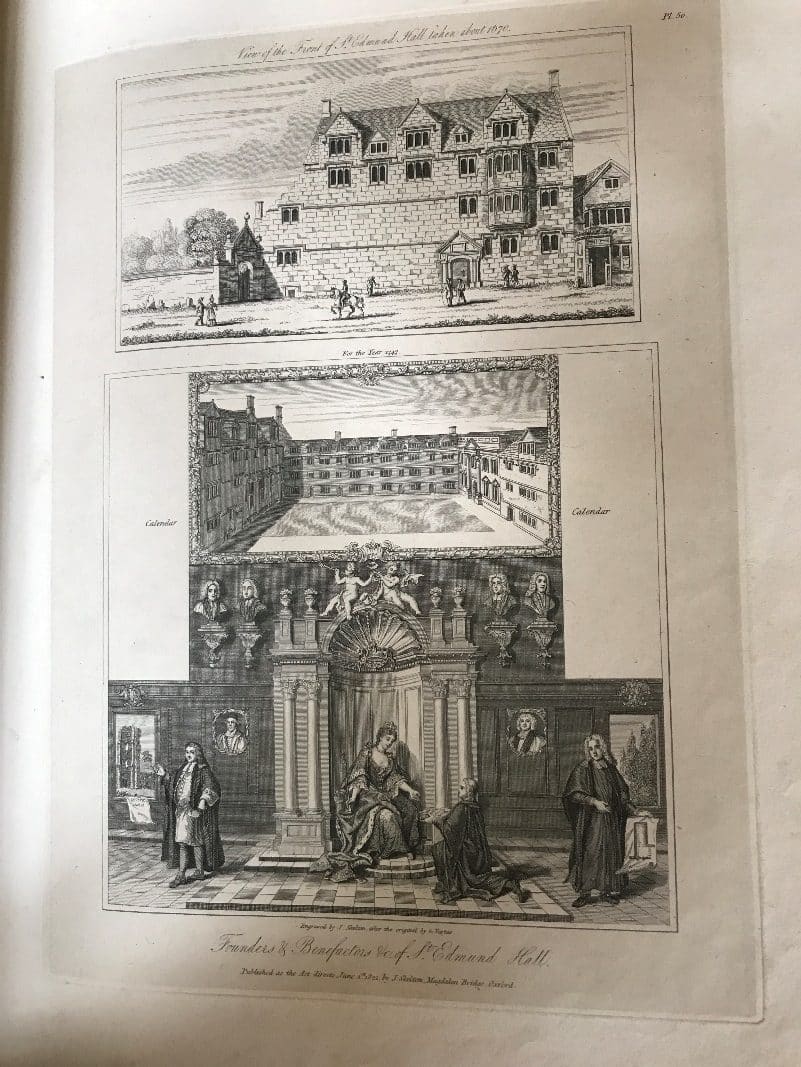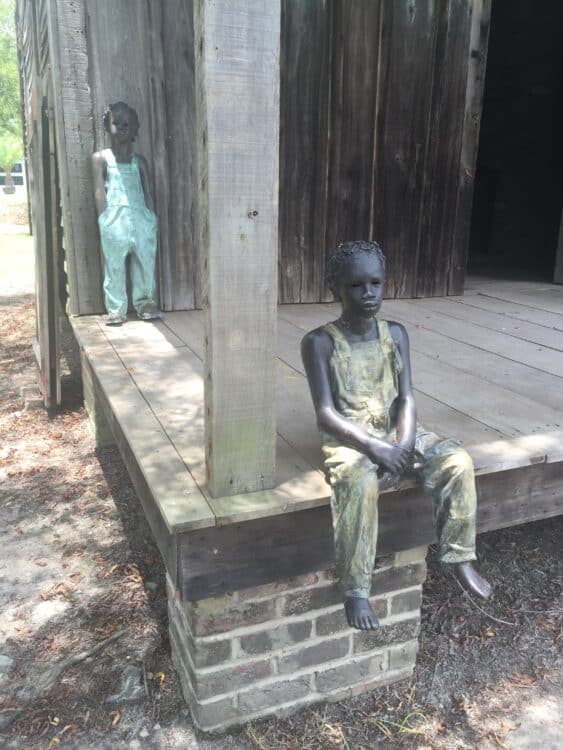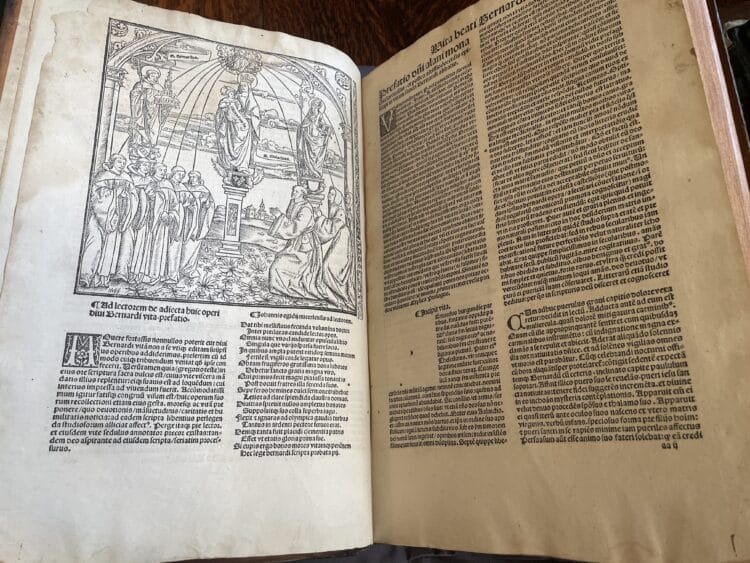'Neat and commodious': Some views of Teddy Hall and Oxford
5 Jun 2019|James Howarth
- Library, Arts & Archives
Last weekend we welcomed the parents of Teddy Hall students to a garden party in College. They were treated to glorious sunshine, drinks in the church yard, a fabulous lunch and tours of the Hall culminating in the Old Library where we had put out a display of images of Teddy Hall and the University from our collections. These are some of the highlights.
John Speed, Oxfordshire described with ye citie and the armes of the colledges of yt famous University. Ao. 1605. (London, 1627)


This map is in a scrapbook of antiquarian maps and views of Oxford and the surrounding countryside compiled by Alfred Brotherston Emden (Principal 1929-1951). The Library owes many of its greatest treasures to the generous gifts of Emden, who was particularly keen for us to hold works reflecting the history of the University and of notable Aularians.
The map is decorated with the coats of arms of 6 Colleges, this of course doesn’t include Teddy Hall which at this point was still only an undergraduate hall lacking a fellowship, a permanent endowment and was under the administration of Queen’s college. However, in the inset map of the city, the Hall and St Peter-in-the-East (now our Library) can be clearly seen.
SEH Shelf Mark: LL 3(6)
David Loggan, Oxonia illustrata. (London, 1714)

This illustration shows St Edmund Hall as it would have looked at the time of the Old Library’s construction in the early 1680s and is the earliest known depiction of the Hall.
Loggan’s book was originally published in 1675 and contains illustrations of all the colleges and buildings of the University.
Apart from the striking stepped wall on the left, the current frontage of the Hall can be quickly recognised in the picture. It dates from the 1650s when the current Old Dining Hall was built.
SEH Shelf Mark: KK172
James Miller, The Humours of Oxford. (London, 1730)

A scabrous and satiric view of Oxford is shown in this play by James Miller (1704-1744). Originally written whilst he was a student at Wadham in the 1720s, it was afterwards staged to some acclaim at the Theatre Royal in Drury Lane in 1730.
In the play, ‘Lady Science,’ a caricatured bluestocking figure, is pursued by various dissolute fellows including Haughty ‘an imperious, Pedantick, unmannerly pedagogue; of vile Life and vicious Principles’ and Ape-all ‘an Oxford Scholar, a trifling ridiculous fop. Affecting Dress and Lewdness and a Contemner of Learning.’
The title page, after a design by Hogarth, shows two drunken dons being remonstrate by a more sober third.
SEH Shelf Mark: MM 51(2)
John Donowell, A view of the Radcliffe Library. (London, 1755)
(a), Brazen nose College (b), the west Front of All Souls College (c), part of the Schools (d), a distant view of the Tower of Wadham College (e), &c. in the University of Oxford.

This engraving is in a volume of six views of Oxford published in the 1750s by the engraver and print seller John Tinney. Our copy is again part of AB Emden’s huge contribution to the collections in the Old Library.
I particularly like the passing figures in this picture, the scholar looking up at All Souls, the lady with the astonishingly wide dress and the servant hurrying on his way with a full basket perched on his head.
The print has parallel titles in English and French, and familiar College names are rendered rather stark in translation: Brasenose is ‘College du Nez de Bronze’ and All Souls is ‘College des Morts.’
SEH Shelf Mark: PP 42 (6)
William Combe, A history of the University of Oxford, its colleges, halls, and public buildings. In two volumes. (London, 1814)


The rather gothic rendition of the crypt of St Peter-in the East, complete with skulls and looming shadows, offers a marked contrast to the bucolic view of the Hall’s Chapel and Library in this illustrated history of the University.
Apparently then, as now, the Hall was in the care of skilled gardeners and the lawn looked after with a dedication that will be familiar to anyone who saw the new turf being laid during the Easter vacation. This heritage of bringing nature into our small site is being continued and developed by our new living wall.
SEH Shelf Mark: BB 58-59
Joseph Skelton, Oxonia antiqua restaurata. (London, 1823)
Containing upwards of one hundred and seventy engravings, amongst which are numerous representations of buildings in Oxford, now either altered or demolished, and which have never been before engraved: the whole forming an illustration of the colleges, halls, and public buildings in this University.

Two older images of the Hall are shown in Oxonia antiqua restaurata, in which Joseph Skelton reproduced many antiquarian images of Oxford as well as new engravings of drawings by Frederick Mackezie.
At the top is a modified version of Loggan’s drawing (the Hall ‘as it appeared in the reign of Charles II’ notes the accompanying text). Below is a reproduction of the Oxford Almanac for 1747 which shows the three then extant sides of the front quad (the north side looking considerably different to its current style) and three of the most distinguished Aularians: John Mill (Principal 1685- 1707), who is presenting his edition of the Greek New Testament to Queen Anne, Stephen Penton (Principal 1674-1685), holding the plans for the Chapel and Library which he instigated the building of, and the antiquarian Thomas Hearne (m.1696).
SEH Shelf Mark: LL8
Edmund Hort New, New Loggan series prints of the University and College buildings of Oxford. (Oxford, 1907-31)

Edmund Hort New was a prolific book illustrator in the late 19th and early 20th century. He worked on this project to create updated version of Loggan’s illustrations occupied the last 25 years of his life and remains unfinished. Our copy of his prints is a unique dummy copy of the projected final volume, with sheets of handmade paper inserted, covered in pencil notes describing the intended contents.
The image of Teddy Hall captures us in 1920 just as the Hall was about to emerge into independence from Queen’s. Strikingly the front quad is still not complete and the old false facade of the Library and Chapel can be clearly seen as it was before they were extended in 1928.
SEH Shelf Mark: LL 4
The new Oxford guide: or, Companion through the University. (Oxford, 1768).
Exhibiting every particular worthy the observation of the curious in each of the public buildings, colleges, halls, &c. … By a gentleman of Oxford.

Finally, a very short account of the Hall without even any pictures. The five halls which still survived in 1768 get rather short shrift in this early tourist guide: only one page out of 137, less than is devoted to a suggested day trip to Stow on the Wold. Teddy Hall is described in only five lines (considerably less than for an advert for ‘Glass’s Magnesia’ at the back of the book) but I rather like the summing of the Chapel, Dining Hall and Library as ‘neat and commodious.’
SEH Shelf Mark: e.3.14(1)
Category: Library, Arts & Archives
Author

James
Howarth
James has been St Edmund Hall’s Librarian since May 2018. He is responsible for maintaining and developing the library’s collections – including the historic and special collections that are housed in the seventeenth-century Old Library and is keen to promote their use in research, study and outreach.

